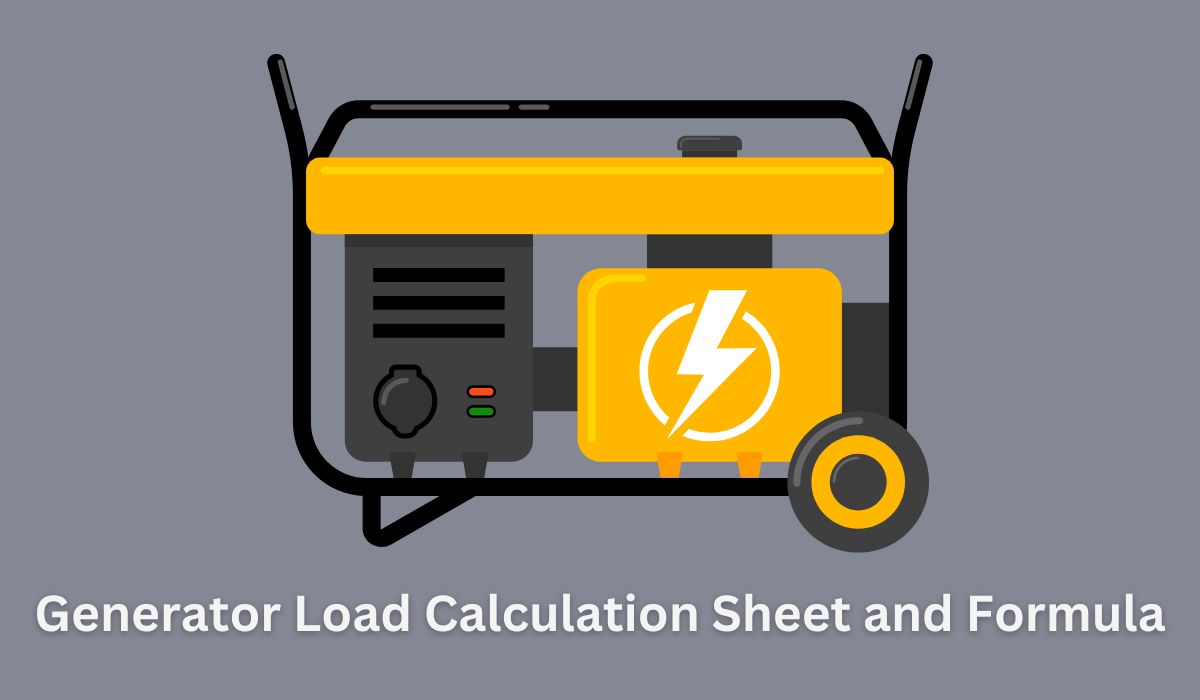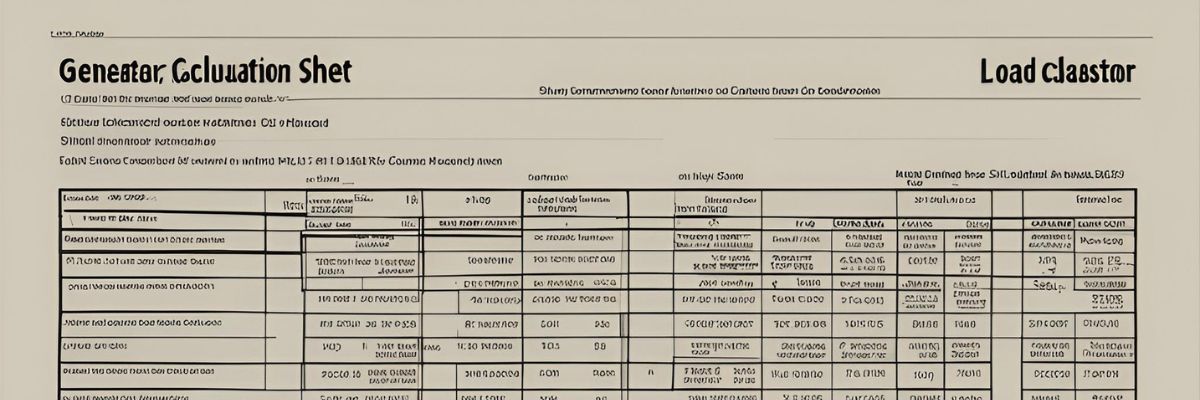Generator Load Calculation Sheet and Formula

* This site contains affiliate links for which we may be compensated.
Accurate load calculations are essential for optimizing generator usage, ensuring efficiency, and preventing system overloads. This article explores the significance of the generator load calculation sheet—a vital tool for determining the correct generator size based on the total power requirements of all devices intended to be powered simultaneously. Understanding how to accurately calculate your power needs is fundamental in selecting a generator that not only meets your demands but also operates efficiently under load conditions.
Understanding Generator Load Calculation
What is Generator Load Calculation and Why is it Crucial?
Generator load calculation involves determining the total wattage required to operate all your electrical devices at once. It’s crucial for selecting a generator that can handle the load without being overloaded, ensuring reliability, safety, and longevity of both the generator and the electrical devices it powers.
Difference Between Running Watts and Starting Watts
Running Watts: The continuous watts needed to keep items running. It’s the steady state of power consumption once an appliance has started.
Starting Watts: Also known as peak watts, these are higher watts required to start motor-driven products like refrigerators, fans, and pumps. Starting watts are critical to consider as they ensure the generator can handle the initial surge without tripping or failing.
Accurate load calculations are vital in scenarios like home backup during power outages, powering RVs during travel, or providing electricity for events and construction sites. Each scenario demands precise calculations to avoid power shortages or equipment damage, ensuring all connected devices can operate without interruption.
Components of a Generator Load Calculation Sheet

Detailed Breakdown of a Load Calculation Sheet
A typical load calculation sheet is a structured document or spreadsheet where you list all appliances and equipment, their running watts, starting watts, and the total of both. This sheet helps in visualizing and managing the power requirements of various devices.
Key Elements of the Load Calculation Sheet
• Appliance/Equipment List: Inventory of all devices that require power.
• Running Watts: Continuous power needs of each appliance.
• Starting Watts: Initial extra power needed to start the appliance.
• Total Wattage: Sum of all running and starting watts, providing a clear view of the total power needed.
Steps to Accurately Calculate Your Load
Step-by-Step Guide to Using a Generator Load Calculation Sheet
1. Identify Appliances: List all appliances and electronic devices that need power during a power outage or when off-grid.
2. Find Wattage Requirements: Consult the user manuals or manufacturer labels on appliances for their wattage requirements. If unavailable, use a watt meter to determine accurate consumption.
3. Account for Running and Starting Watts: Note both values for each appliance, as some may have significant differences between running and peak startup demands.
4. Sum Total Wattage: Add all running and starting watts to determine the total power needed. This sum dictates the minimum output your generator should have.
Generator Load Calculation Formula Example
Total Load (Watts) = ∑(Power Consumption of Each Device)
Where:
Power (Watts) = Voltage (Volts) × Current (Amps)
Adjusted Power (Watts) = Total Load (Watts) / Power Factor
For each device, find the power consumption in watts. If only voltage and current are known, use the formula:
Power (Watts) = Voltage (Volts) × Current (Amps)
For devices with inductive loads, consider the power factor (typically between 0.7 and 0.9). Adjust the total load using the formula:
Adjusted Power (Watts) = Total Load (Watts) / Power Factor
Example Calculation:
Light bulb: 60 watts
Refrigerator: 200 watts (800 watts starting)
TV: 100 watts
Laptop: 50 watts
Total Running Load:
60 W (Light bulb) + 200 W (Refrigerator) +100 W (TV)+ 50 W (Laptop) = 410 W
Starting Load (Consider the highest starting watts):
410 W (Running Load) + 600 W (Extra for Refrigerator Starting) = 1010 W
Additional Considerations:
Power Factor (PF): For inductive loads, adjust the total load considering the power factor.
Adjusted Power (Watts) = 1010 W / 0.8 = 1262.5 W
Practical Tips for Load Calculation

Common errors include underestimating peak demand, forgetting to add starting watts, or miscalculating the total number of devices powered simultaneously. Double-check calculations and consider unexpected additions or uses.
For instance, a refrigerator may use 700 running watts but can require up to 2200 starting watts. A window air conditioner might run at 1200 watts but need 1800 to start.
Consider potential future additions like extra lighting, computers, or tools. Planning for additional capacity can prevent the need for urgent generator upgrades.
Choosing the Right Generator Based on Load Calculation
Interpreting Load Calculation Results
The total wattage calculated will guide you in choosing a generator with adequate output to handle your needs, considering both running and starting watts.
Matching Generator Capacity
It’s advisable to select a generator that offers a slightly higher wattage than calculated to provide a buffer for unforeseen power needs and to reduce strain on the generator.
Factors Beyond Wattage
Consider generator fuel type (gasoline, diesel, propane, or dual-fuel options), portability for easy movement, and noise level, which is particularly important in residential or public settings.
Load Management Strategies
Efficient load management maximizes generator utility and prolongs its lifespan:
Prioritizing Essential Appliances: Determine which appliances are essential and should be powered first, such as refrigerators, heating systems, or medical equipment.
Using Power Strips and Surge Protectors: These help manage multiple devices more efficiently and protect them from potential power surges.
Implementing Load-Shedding: During peak usage, selectively turn off non-essential appliances to prevent overloading the generator.
Tools and Resources for Load Calculation

Utilize online resources for quick and efficient load calculations. Websites like Electric Generators Direct or Consumer Reports often feature tools that can help you calculate the total wattage needed by inputting your appliances and their respective wattages.
Printable Sheets and Templates
You can download and use specific templates for manually calculating your generator load:
• Back Up Generator Worksheet – Load Calculations: This comprehensive worksheet helps you list and calculate the power requirements of various household items.
• Lambertville NJ Generator Load Calculation Form: A detailed form provided by the Lambertville construction office for calculating generator load.
• Homelite Wattage Worksheet: A simple worksheet to help you estimate the wattage needed for various appliances and tools.
These resources are available in PDF format for easy download and printing. They include sections for listing appliances, their running and starting watts, and help in calculating the total wattage required.
To ensure your load calculations are precise, consider using a watt meter. These devices can be purchased from hardware stores or online marketplaces like Amazon. They are instrumental in measuring the actual power usage of appliances, especially if the wattage information is not readily available on the appliance itself.
Maintenance and Safety Considerations
Ensuring Safety with Calculated Loads
Verify that your generator can safely handle the calculated load. Overloading a generator can lead to failures and safety hazards.
Regular Maintenance for Optimal Performance
Regularly check oil levels, air filters, and conduct general inspections to ensure your generator is in good working condition.
Safety Guidelines for Operating Generators
Always operate generators in well-ventilated areas to avoid carbon monoxide poisoning. Ensure all connections are secure and use heavy-duty extension cords.
Conclusion
Accurate load calculations are crucial for the effective selection and use of generators. They ensure that the generator size matches the power needs without causing overloads. Regular updates to the load calculation sheet as your power needs change can help maintain the balance between necessity and generator capacity, ensuring safety, efficiency in its operation and not worrying about repair or buying new generator parts.







